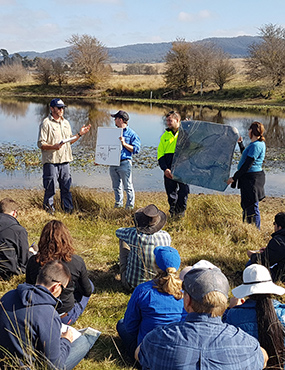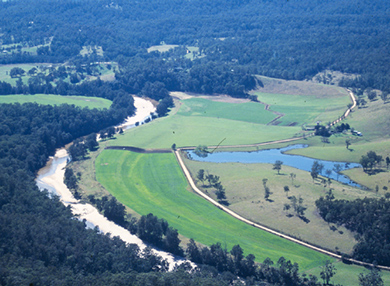Learning to live with rivers
Healthy rivers are vital to the survival of communities and ecosystems. Macquarie’s River Styles Framework has contributed to improving river management around the world by creating a new way to understand river processes.

Guiding river management best practice
Know your river. Know your catchment. Work with nature. Understand that rivers are diverse, dynamic entities which we need to adapt to living with. These principles drive the international best practice River Styles Framework developed by Macquarie’s Professor Kirstie Fryirs and fellow scientist Professor Gary Brierley.
The River Styles Framework was one of thirteen high impact research projects featured in the inaugural NSW Research Impact Showcase (2022). The Framework is helping a growing number of government agencies and conservation groups to:
- better assess and understand the nature of rivers
- develop sustainable strategies for river conservation and rehabilitation.
River diversity
Rivers are diverse. They differ remarkably in character (‘morphology’) and behaviour. NSW alone contains 47 different styles of rivers, while more than 70 unique river styles have been identified globally.
Rivers evolve and change. Human activity and natural disturbances have impacted a significant proportion of rivers, altering their character and behaviour, and leaving many in a poor condition.
Understanding the style of a river and how it has evolved is key to diagnosing its health and deciding how to best work with natural processes to improve its condition. The River Styles Framework gives decision makers the tools to recognise rivers as diverse systems, and effectively diagnose and treat problems.
A pioneering approach to informing river management
Before the River Styles Framework, river management policy makers and practitioners lacked a consistent way to identify different river types and assess their health and recovery potential.
The framework is based on more than 20 years of internationally recognised, award-winning research on the morphology, function and evolution of rivers.
Instead of classifying rivers, the framework characterises them. This open-ended, place-based approach to river analysis ensures that rivers are managed according to their individual characteristics and needs.
This is a cost-effective approach, enabling efficient spending of public money. A 2010 Land and Water Australia (LWA) cost-benefit analysis showed that the net value of River Styles was $40 million, a figure that has since likely significantly increased with the framework’s rollout across NSW and internationally.
Worldwide impact
The River Styles Framework has been adopted in a growing number of countries across six continents. Worldwide, hundreds of thousands of kilometres of river length have been assessed and more than 500 professional River Stylers trained.
Specific applications of the framework are as diverse as rivers themselves:
- The NSW government used the framework to develop the NSW Rivers Styles Database, released in 2020. This open access database provides a wealth of information for more than 225,000 kilometres of rivers and major streams located in NSW. Local, regional and state agencies can draw on these data to help prioritise and plan river management programs.
- The River Styles Framework informs part of the NSW Government's River Condition Index (RCI). River management agencies use the RCI for state of environment reporting, river health assessment and identification of high value ecological systems.
- NSW Fisheries are using the framework to assess threatened fish species distributions across NSW. Download NSW Fisheries use case study document.
- In northwest USA, the River Styles Framework is helping maintain healthy fish populations. The framework has significantly informed the salmon habitat monitoring protocol designed by the Columbia Habitat Monitoring Program (CHaMP). Download CHaMP use case study document.
- The European Union faced the challenge of developing a fit-for-purpose framework for assessing the morphology and water quality of its rivers post-restoration. The ensuing REFORM project and European Morphological Quality Index (MQI) built on and adapted core elements of the River Styles Framework. Download REFORM use case study document.
Key partners
6 Wally’s Walk
Macquarie University NSW 2109